The Effects of Pandemic Restrictions on Public Health—Improvements in Urban Air Quality
Abstract
:1. Introduction
2. Materials and Methods
2.1. Data Source
2.2. Air Pollution Index (API) and Air Quality Index (AQI)
2.3. Restriction Index (RES)
| RES (X) | = sumday1 [restriction1 (X); restriction2 (X); … restrictionn (X)] |
| + sumday2 [restriction1 (X); restriction2 (X); … restrictionn (X)] | |
| + … | |
| + sumday14 [restriction1 (X); restriction2 (X); … restrictionn (X)] |
2.4. Descriptive Statistics and Hypothesis Testing
3. Results
3.1. Urban Air Pollution and Restriction Index Values
3.2. Meteorological Analysis
3.3. Individual Air Pollutants Analysis
3.4. ARX Model
4. Discussion
5. Conclusions
Author Contributions
Funding
Institutional Review Board Statement
Informed Consent Statement
Data Availability Statement
Conflicts of Interest
Glossary of Symbols
| Symbol | Description |
| NO2 | Nitrogen dioxide |
| SO2 | Sulphur dioxide |
| CO | Carbon monoxide |
| PM2.5 | Particle matter under 2.5 microns diameter |
| PM10 | Particle matter under 10 microns diameter |
| NASA | The National Aeronautics and Space Administration |
| COVID-19 | Coronavirus Disease 2019 |
| SARS-CoV-2 | Severe acute respiratory syndrome coronavirus 2 |
| WHO | World Health Organization |
| N95 masks | Respirators that filter out 95 percent of airborne particles |
| EPA | United States Environmental Protection Agency |
| PPB | Parts per billion |
| OCO2 | NASA Orbiting Carbon Observatory 2 product |
| CAMS | Copernicus Atmosphere Monitoring Service |
| ERA5 satellite | The fifth generation ECMWF atmospheric reanalysis of the global climate |
| NACE rev. 2 | Statistical classification of economic activities in the European Community |
| US EPA standard | United States Environmental Protection Agency data standards |
| NAAQS | National ambient air quality standard |
| IP | Air pollution score for each pollutant |
| CP | The period average truncated concentration for each pollutant |
| BPHi | The concentration breakpoint first to exceed the CP |
| BPLo | The concentration breakpoint first below the CP |
| IHi | The AQI values corresponding to BPHi |
| ILo | The AQI values corresponding to BPLo |
| ARX | Autoregressive model with exogenous input |
| APIchange | Air pollution index changes |
| APIperiod y (X) | The air pollution index for each of the three periods: 1 March–30 May, 1 June–30 August and 1 September–30 October |
| X | Each country taken into consideration |
| P | Pollutant |
| US | United States |
| PPM | Parts per million |
| NetCDF | Network Common Data Form |
References
- Glencross, D.A.; Ho, T.R.; Camiña, N.; Hawrylowicz, C.M.; Pfeffer, P.E. Air Pollution and Its Effects on the Immune System. Free Radic. Biol. Med. 2020, 151, 56–68. [Google Scholar] [CrossRef] [PubMed]
- Williams, D.D.R. Earth Fact Sheet. Available online: https://nssdc.gsfc.nasa.gov/planetary/factsheet/earthfact.html (accessed on 19 November 2020).
- Vallero, D. Fundamentals of Air Pollution; Academic Press—Elsevier: Cambridge, MA, USA, 2008; ISBN 0133325377. [Google Scholar]
- Moraru, R.I.; Băbuţ, G.B.; Cioca, L.I. Study of Methane Flow in Caved Goafs Ajacent to Longwall Faces in Valea Jiului Coal Basin. In Proceedings of the 13th International Multidisciplinary Scientific GeoConference SGEM, Albena, Bulgaria, 16–22 June 2013; p. 8. [Google Scholar]
- Yuki, K.; Fujiogi, M.; Koutsogiannaki, S. COVID-19 Pathophysiology: A Review. Clin. Immunol. 2020, 215, 108427. [Google Scholar] [CrossRef] [PubMed]
- Wang, P.; Chen, K.; Zhu, S.; Wang, P.; Zhang, H. Severe Air Pollution Events Not Avoided by Reduced Anthropogenic Activities during COVID-19 Outbreak. Resour. Conserv. Recycl. 2020, 158, 104814. [Google Scholar] [CrossRef] [PubMed]
- Baloch, S.; Baloch, M.A.; Zheng, T.; Pei, X. The Coronavirus Disease 2019 (COVID-19) Pandemic. Tohoku J. Exp. Med. 2020, 250, 271–278. [Google Scholar] [CrossRef] [PubMed] [Green Version]
- Hammett, E. How Long Does Coronavirus Survive on Different Surfaces? BDJ Team 2020, 7, 14–15. [Google Scholar] [CrossRef]
- Chu, D.K.; Akl, E.A.; Duda, S.; Solo, K.; Yaacoub, S.; Schünemann, H.J.; Chu, D.K.; Akl, E.A.; El-harakeh, A.; Bognanni, A.; et al. Physical Distancing, Face Masks, and Eye Protection to Prevent Person-to-Person Transmission of SARS-CoV-2 and COVID-19: A Systematic Review and Meta-Analysis. Lancet 2020, 395, 1973–1987. [Google Scholar] [CrossRef]
- Kraemer, M.U.G.; Yang, C.-H.; Gutierrez, B.; Wu, C.-H.; Klein, B.; Pigott, D.M.; du Plessis, L.; Faria, N.R.; Li, R.; Hanage, W.P.; et al. The Effect of Human Mobility and Control Measures on the COVID-19 Epidemic in China. Science 2020, 368, 493–497. [Google Scholar] [CrossRef] [Green Version]
- Saglietto, A.; D’Ascenzo, F.; Zoccai, G.B.; De Ferrari, G.M. COVID-19 in Europe: The Italian Lesson. Lancet 2020, 395, 1110–1111. [Google Scholar] [CrossRef]
- Rothan, H.A.; Byrareddy, S.N. The Epidemiology and Pathogenesis of Coronavirus Disease (COVID-19) Outbreak. J. Autoimmun. 2020, 109, 102433. [Google Scholar] [CrossRef]
- IEA. Global Energy Review 2020; OECD: Paris, France, 2020; ISBN 9789264362161. [Google Scholar]
- Eurostat. NACE Rev. 2—Statistical Classification of Economic Activities in the European Community; Eurostat: Luxembourg, 2008; ISBN 978-92-79-04741-1. [Google Scholar]
- Cioca, L.I.; Ivascu, L.; Rada, E.C.; Torretta, V.; Ionescu, G. Sustainable Development and Technological Impact on CO2 Reducing Conditions in Romania. Sustainability 2015, 7, 1637–1650. [Google Scholar] [CrossRef] [Green Version]
- Liu, Y.; Zhou, Y.; Lu, J. Exploring the Relationship between Air Pollution and Meteorological Conditions in China under Environmental Governance. Sci. Rep. 2020, 10, 14518. [Google Scholar] [CrossRef] [PubMed]
- Sujatha, P.; Mahalakshmi, D.V.; Ramiz, A.; Rao, P.V.N.; Naidu, C.V. Ventilation Coefficient and Boundary Layer Height Impact on Urban Air Quality. Cogent Environ. Sci. 2016, 2, 1125284. [Google Scholar] [CrossRef]
- Transportation Research Board and National Research Council. Managing Carbon Monoxide Pollution in Meteorological and Topographical Problem Areas; National Academies Press: Washington, DC, USA, 2003; ISBN 978-0-309-08923-4. [Google Scholar]
- Manisalidis, I.; Stavropoulou, E.; Stavropoulos, A.; Bezirtzoglou, E. Environmental and Health Impacts of Air Pollution: A Review. Front. Public Health 2020, 8, 14. [Google Scholar] [CrossRef] [Green Version]
- Townsend, C.L.; Maynard, R.L. Effects on Health of Prolonged Exposure to Low Concentrations of Carbon Monoxide. Occup. Environ. Med. 2002, 59, 708–711. [Google Scholar] [CrossRef] [PubMed] [Green Version]
- Raub, J.A.; Mathieu-Nolf, M.; Hampson, N.B.; Thom, S.R. Carbon Monoxide Poisoning—A Public Health Perspective. Toxicology 2000, 145, 1–14. [Google Scholar] [CrossRef]
- Cameletti, M. The Effect of Corona Virus Lockdown on Air Pollution: Evidence from the City of Brescia in Lombardia Region (Italy). Atmos. Environ. 2020, 239, 117794. [Google Scholar] [CrossRef] [PubMed]
- Islam, M.S.; Rahman, M.; Tusher, T.R.; Roy, S.; Razi, M.A. Assessing the Relationship between COVID-19, Air Quality, and Meteorological Variables: A Case Study of Dhaka City in Bangladesh. Aerosol Air Qual. Res. 2021, 21, 200609. [Google Scholar] [CrossRef]
- Petetin, H.; Bowdalo, D.; Soret, A.; Guevara, M.; Jorba, O.; Serradell, K.; Pérez García-Pando, C. Meteorology-Normalized Impact of the COVID-19 Lockdown upon NO2 Pollution in Spain. Atmos. Chem. Phys. 2020, 20, 11119–11141. [Google Scholar] [CrossRef]
- Tian, H.; Xu, R.; Canadell, J.G.; Thompson, R.L.; Winiwarter, W.; Suntharalingam, P.; Davidson, E.A.; Ciais, P.; Jackson, R.B.; Janssens-Maenhout, G.; et al. A Comprehensive Quantification of Global Nitrous Oxide Sources and Sinks. Nature 2020, 586, 248–256. [Google Scholar] [CrossRef]
- Sutton, M.A.; Howard, C.M.; Erisman, J.W.; Billen, G.; Bleeker, A.; van Grinsven, H.; Grizzetti, B. The European Nitrogen Assessment: Sources, Effects and Policy Perspectives; Cambridge University Press: New York, NY, USA, 2011. [Google Scholar]
- Grad, R. Health Effects of Air Pollution. Lancet 1999, 354, 1653. [Google Scholar] [CrossRef]
- Srimuruganandam, B.; Shiva Nagendra, S.M. Source Characterization of PM 10 and PM 2.5 Mass Using a Chemical Mass Balance Model at Urban Roadside. Sci. Total Environ. 2012, 433, 8–19. [Google Scholar] [CrossRef] [PubMed]
- Petrescu, V.; Ciudin, R.; Cioca, L.I.; Isarie, C.L.; Trif, B.; Nederita, V. The Impact of Traffic Related Pollution on Air Quality In Sibiu. Environ. Eng. Manag. J. 2015, 14, 2637–2642. [Google Scholar]
- Misra, C.; Geller, M.D.; Shah, P.; Sioutas, C.; Solomon, P.A. Development and Evaluation of a Continuous Coarse (PM 10–PM 25) Particle Monitor. J. Air Waste Manag. Assoc. 2001, 51, 1309–1317. [Google Scholar] [CrossRef] [PubMed]
- Li, N.; Wang, M.; Bramble, L.A.; Schmitz, D.A.; Schauer, J.J.; Sioutas, C.; Harkema, J.R.; Nel, A.E. The Adjuvant Effect of Ambient Particulate Matter Is Closely Reflected by the Particulate Oxidant Potential. Environ. Health Perspect. 2009, 117, 1116–1123. [Google Scholar] [CrossRef] [PubMed]
- Arghya Sardar, P.R. SO2 Emission Control and Finding a Way out to Produce Sulphuric Acid from Industrial SO2 Emission. J. Chem. Eng. Process Technol. 2015, 6, 1000230. [Google Scholar] [CrossRef] [Green Version]
- Ding, G.; Thuy, N. Carbon Management. In Advances in Carbon Management Technologies; CRC Press: Boca Raton, FL, USA, 2020. [Google Scholar]
- Reddy, M.S.; Venkataraman, C. Inventory of Aerosol and Sulphur Dioxide Emissions from India. Part II—Biomass Combustion. Atmos. Environ. 2002, 36, 699–712. [Google Scholar] [CrossRef]
- Fioletov, V.E.; McLinden, C.A.; Krotkov, N.; Li, C.; Joiner, J.; Theys, N.; Carn, S.; Moran, M.D. A Global Catalogue of Large SO2 Sources and Emissions Derived from the Ozone Monitoring Instrument. Atmos. Chem. Phys. 2016, 16, 11497–11519. [Google Scholar] [CrossRef] [Green Version]
- Shakil, M.H.; Munim, Z.H.; Tasnia, M.; Sarowar, S. COVID-19 and the Environment: A Critical Review and Research Agenda. Sci. Total Environ. 2020, 745, 141022. [Google Scholar] [CrossRef]
- Eroğlu, H. Effects of COVID-19 Outbreak on Environment and Renewable Energy Sector. Environ. Dev. Sustain. 2021, 23, 4782–4790. [Google Scholar] [CrossRef]
- SanJuan-Reyes, S.; Gómez-Oliván, L.M.; Islas-Flores, H. COVID-19 in the Environment. Chemosphere 2021, 263, 127973. [Google Scholar] [CrossRef]
- Filonchyk, M.; Hurynovich, V.; Yan, H. Impact of COVID-19 Pandemic on Air Pollution in Poland Based on Surface Measurements and Satellite Data. Aerosol Air Qual. Res. 2021, 21, 200472. [Google Scholar] [CrossRef]
- Balasubramaniam, D.; Kanmanipappa, C.; Shankarlal, B.; Saravanan, M. Assessing the Impact of Lockdown in US, Italy and France—What Are the Changes in Air Quality? Energy Sources Part A Recover. Util. Environ. Eff. 2020, 43, 1837300. [Google Scholar] [CrossRef]
- Paital, B. Nurture to Nature via COVID-19, a Self-Regenerating Environmental Strategy of Environment in Global Context. Sci. Total Environ. 2020, 729, 139088. [Google Scholar] [CrossRef] [PubMed]
- Berman, J.D.; Ebisu, K. Changes in U.S. Air Pollution during the COVID-19 Pandemic. Sci. Total Environ. 2020, 739, 139864. [Google Scholar] [CrossRef] [PubMed]
- Muhammad, S.; Long, X.; Salman, M. COVID-19 Pandemic and Environmental Pollution: A Blessing in Disguise? Sci. Total Environ. 2020, 728, 138820. [Google Scholar] [CrossRef] [PubMed]
- Rupani, P.F.; Nilashi, M.; Abumalloh, R.A.; Asadi, S.; Samad, S.; Wang, S. Coronavirus Pandemic (COVID-19) and Its Natural Environmental Impacts. Int. J. Environ. Sci. Technol. 2020, 17, 4655–4666. [Google Scholar] [CrossRef]
- Jephcote, C.; Hansell, A.L.; Adams, K.; Gulliver, J. Changes in Air Quality during COVID-19 ‘Lockdown’ in the United Kingdom. Environ. Pollut. 2021, 272, 116011. [Google Scholar] [CrossRef]
- Vultaggio, M.; Varrica, D.; Alaimo, M.G. Impact on Air Quality of the COVID-19 Lockdown in the Urban Area of Palermo (Italy). Int. J. Environ. Res. Public Health 2020, 17, 7375. [Google Scholar] [CrossRef]
- Tobías, A.; Carnerero, C.; Reche, C.; Massagué, J.; Via, M.; Minguillón, M.C.; Alastuey, A.; Querol, X. Changes in Air Quality during the Lockdown in Barcelona (Spain) One Month into the SARS-CoV-2 Epidemic. Sci. Total Environ. 2020, 726, 138540. [Google Scholar] [CrossRef]
- Lokhandwala, S.; Gautam, P. Indirect Impact of COVID-19 on Environment: A Brief Study in Indian Context. Environ. Res. 2020, 188, 109807. [Google Scholar] [CrossRef]
- Bao, R.; Zhang, A. Does Lockdown Reduce Air Pollution? Evidence from 44 Cities in Northern China. Sci. Total Environ. 2020, 731, 139052. [Google Scholar] [CrossRef] [PubMed]
- Sharma, S.; Zhang, M.; Anshika; Gao, J.; Zhang, H.; Kota, S.H. Effect of Restricted Emissions during COVID-19 on Air Quality in India. Sci. Total Environ. 2020, 728, 138878. [Google Scholar] [CrossRef] [PubMed]
- Mahato, S.; Pal, S.; Ghosh, K.G. Effect of Lockdown amid COVID-19 Pandemic on Air Quality of the Megacity Delhi, India. Sci. Total Environ. 2020, 730, 139086. [Google Scholar] [CrossRef]
- Fiasca, F.; Minelli, M.; Maio, D.; Minelli, M.; Vergallo, I.; Necozione, S.; Mattei, A. Associations between COVID-19 Incidence Rates and the Exposure to PM2.5 and NO2: A Nationwide Observational Study in Italy. Int. J. Environ. Res. Public Health 2020, 17, 9318. [Google Scholar] [CrossRef]
- Díaz-Avalos, C.; Juan, P.; Chaudhuri, S.; Sáez, M.; Serra, L. Association between the New COVID-19 Cases and Air Pollution with Meteorological Elements in Nine Counties of New York State. Int. J. Environ. Res. Public Health 2020, 17, 9055. [Google Scholar] [CrossRef] [PubMed]
- Hutter, H.P.; Poteser, M.; Moshammer, H.; Lemmerer, K.; Mayer, M.; Weitensfelder, L.; Wallner, P.; Kundi, M. Air Pollution Is Associated with COVID-19 Incidence and Mortality in Vienna, Austria. Int. J. Environ. Res. Public Health 2020, 17, 9275. [Google Scholar] [CrossRef]
- Jasarevic, T.; Thomas, G.; Osseiran, N. 7 Million Deaths Annually Linked to Air Pollution. Available online: https://www.who.int/news/item/25-03-2014-7-million-premature-deaths-annually-linked-to-air-pollution (accessed on 30 May 2021).
- Worldmeter Data. Available online: https://www.worldometers.info/coronavirus/coronavirus-death-rate/ (accessed on 12 November 2020).
- Isaifan, R.J. The Dramatic Impact of Coronavirus Outbreak on Air Quality: Has It Saved as Much as It Has Killed so Far? Glob. J. Environ. Sci. Manag. 2020, 6, 275–288. [Google Scholar] [CrossRef]
- González Ortiz, A.; Gsella, A.; Guerreiro, C.; Soares, J.; Horálek, J. Health Risk Assessment of Air Pollution; Norwegian Institute for Air Research: Kjeller, Norway, 2021. [Google Scholar]

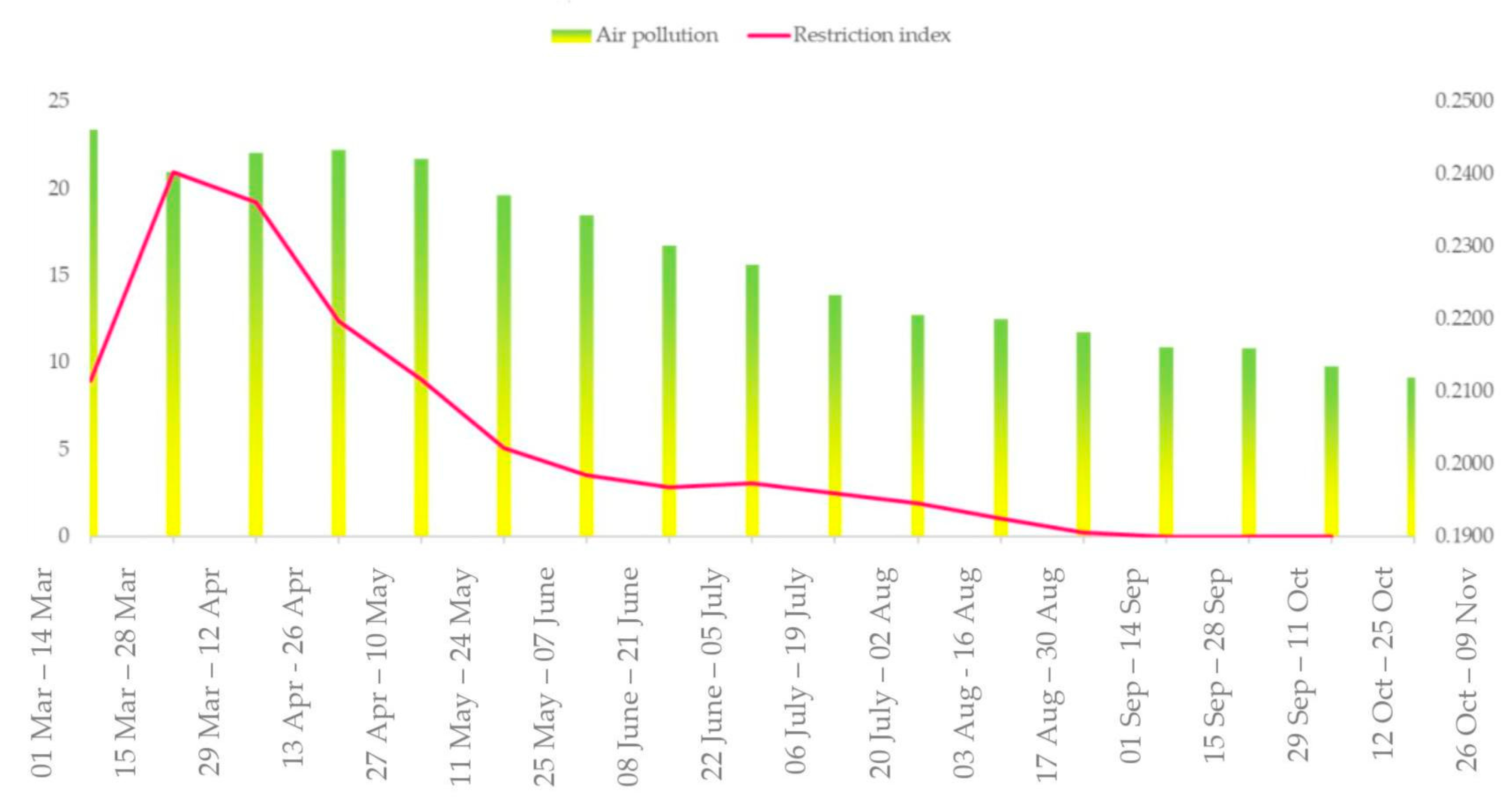
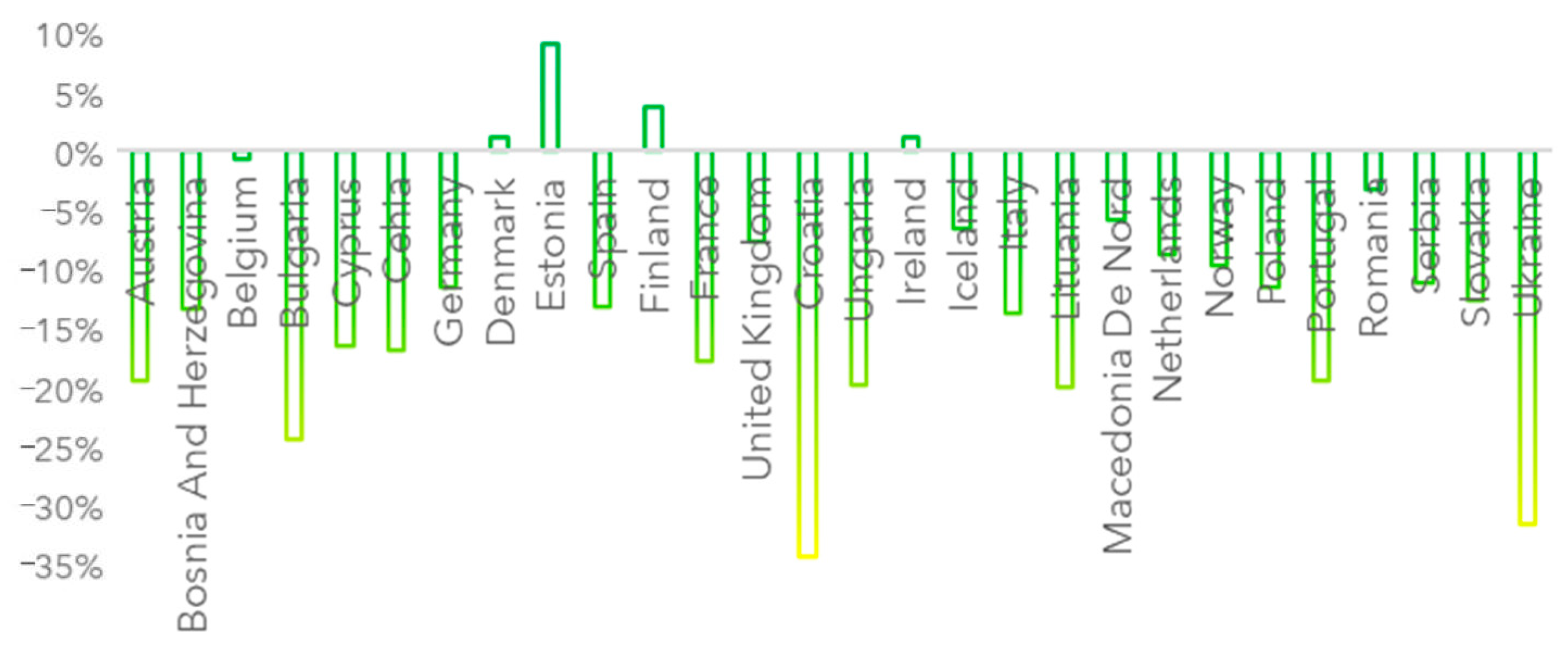


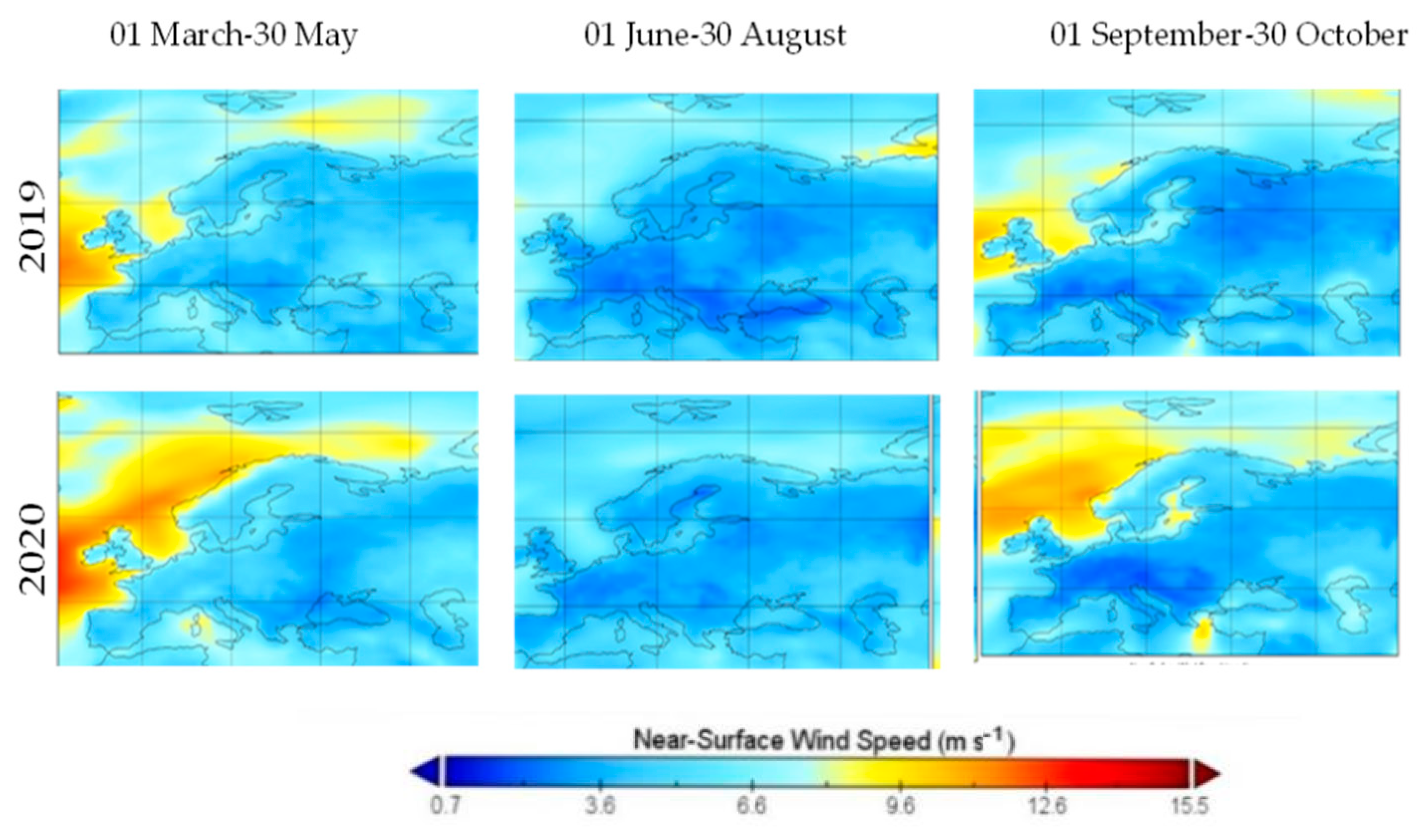


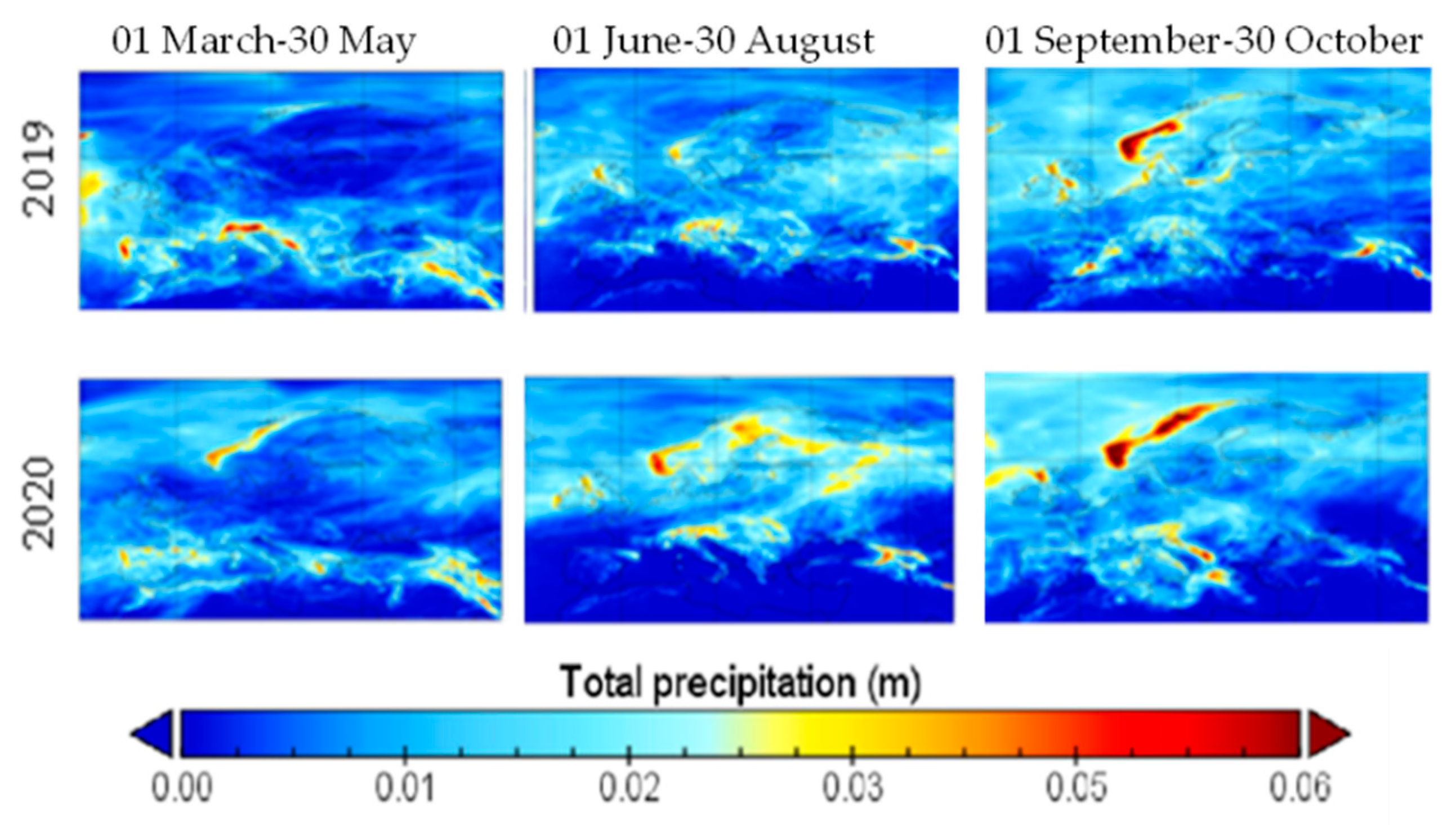



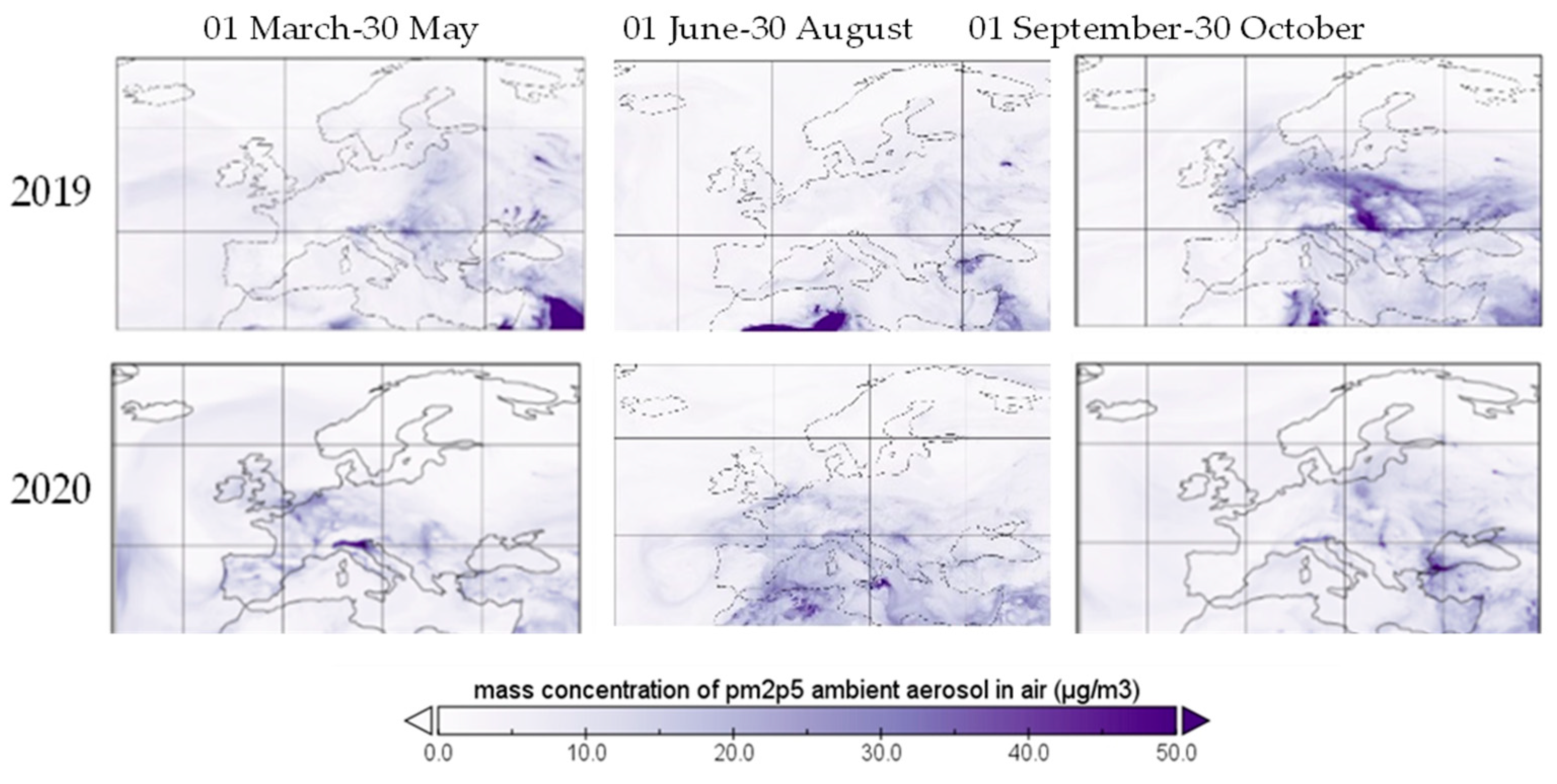


| Name | Parameter | Source | Unit | Vertical Level | Frequency of Available Data | Usage |
|---|---|---|---|---|---|---|
| Sulphur dioxide | SO2 | Environmental Protection Agency repository (EPA) | Parts per million (PPM) | Surface (0 m above ground) | Daily | Air pollution index (API) and air quality index (AQI) |
| Carbon monoxide | CO | EPA | Parts per billion (PPB) | Surface | Daily | API; AQI |
| Nitrogen dioxide | NO2 | EPA | PPB | Surface | Daily | API; AQI |
| Particle matter < 2.5 microns | PM2.5 | EPA | μg/m3 (micrograms per cubic meter air) | Surface | Daily | API; AQI |
| Particle matter < 10 microns | PM10 | EPA | μg/m3 | Surface | Daily | API; AQI |
| Sulphur dioxide concentration in NetCDF | SO2 | NASA Orbiting Carbon Observatory 2 product, through Copernicus Atmosphere Monitoring Service (OCO2, CAMS) | μg/m3 | Surface | Hourly | Map representation |
| Carbon monoxide concentration in NetCDF | CO | OCO2, CAMS | μg/m3 | Surface | Hourly | Map representation |
| Nitrogen dioxide concentration in NetCDF | NO2 | OCO2, CAMS | μg/m3 | Surface | Hourly | Map representation |
| Particle matter < 2.5 microns concentration in NetCDF | PM2.5 | OCO2, CAMS | μg/m3 | Surface | Hourly | Map representation |
| Particle matter < 10 microns concentration in NetCDF | PM10 | OCO2, CAMS | μg/m3 | Surface | Hourly | Map representation |
| Ground level wind speed | WIND | ERA5 satellite through CAMS | Meters/second (m/s) | Surface | Hourly | Map representation and meteorological analysis |
| Near-surface air temperature | TEMP | ERA5 satellite through CAMS | Kelvin degrees (K) | Surface | Hourly | Map representation and meteorological analysis |
| Boundary layer height | - | ERA5 satellite through CAMS | M | Surface | Hourly | Map representation and meteorological analysis |
| Total precipitation | PRECIP | ERA5 satellite through CAMS | M | Surface | Hourly | Map representation and meteorological analysis |
| Restrictions in COVID-19 pandemic | RES | European Centre for Disease Prevention and Control repository | - | - | Daily | Restriction index (RES) |
| Air emission accounts | - | NACE rev. 2 classification from Eurostat repository | - | - | Annually | Identifying the weights for the restriction index |
| National accounts aggregates by industry | - | Eurostat | - | - | Annually | Correlation of the air pollution index with the changes in industrial production and manufacture |
| Period | Usage | Reason |
|---|---|---|
| 14-day period (approx. bimonthly) | Construction of API, AQI and RES index, correlations and ARX approach | The period of incubation for COVID-19 symptoms could extend to 14 days; governments usually took into consideration a two-week lockdown period. |
| 1 March–30 May, 1 June–30 August and 1 September–30 October | Maps of SO2, CO, NO2, PM2.5 and PM10 over Europe; Air pollution and restrictions over Europe; Changes in pollutants concentration in air; Maps of ground level wind speed, near-surface air temperature, boundary layer height and total precipitation. | Analysis of the seasonal changes of the air pollution components over Europe. |
| p-Value | Pearson Correlation | Industry and Manufacture Economic Activities | |
|---|---|---|---|
| 1 | <10% | 0.29542 | Manufacture of textiles, wearing apparel, leather and related products |
| 2 | <10% | 0.29942 | Manufacture of rubber and plastic products |
| 3 | <5% | 0.47511 | Manufacture of motor vehicles, trailers and semi-trailers |
| 4 | <5% | 0.34065 | Activities of households as employers; undifferentiated goods- and services-producing activities of households for own use |
| Correlation of Restriction Index with | Air Quality | PM10 | PM2.5 | SO2 | NO2 | CO |
| 76.65% * | 74.26% * | 71.53% * | 68.01% * | 64.06% * | 64.96% * |
Publisher’s Note: MDPI stays neutral with regard to jurisdictional claims in published maps and institutional affiliations. |
© 2022 by the authors. Licensee MDPI, Basel, Switzerland. This article is an open access article distributed under the terms and conditions of the Creative Commons Attribution (CC BY) license (https://creativecommons.org/licenses/by/4.0/).
Share and Cite
Cioca, G.; Nerişanu, R.A. The Effects of Pandemic Restrictions on Public Health—Improvements in Urban Air Quality. Int. J. Environ. Res. Public Health 2022, 19, 9022. https://doi.org/10.3390/ijerph19159022
Cioca G, Nerişanu RA. The Effects of Pandemic Restrictions on Public Health—Improvements in Urban Air Quality. International Journal of Environmental Research and Public Health. 2022; 19(15):9022. https://doi.org/10.3390/ijerph19159022
Chicago/Turabian StyleCioca, Gabriela, and Raluca Andreea Nerişanu. 2022. "The Effects of Pandemic Restrictions on Public Health—Improvements in Urban Air Quality" International Journal of Environmental Research and Public Health 19, no. 15: 9022. https://doi.org/10.3390/ijerph19159022







